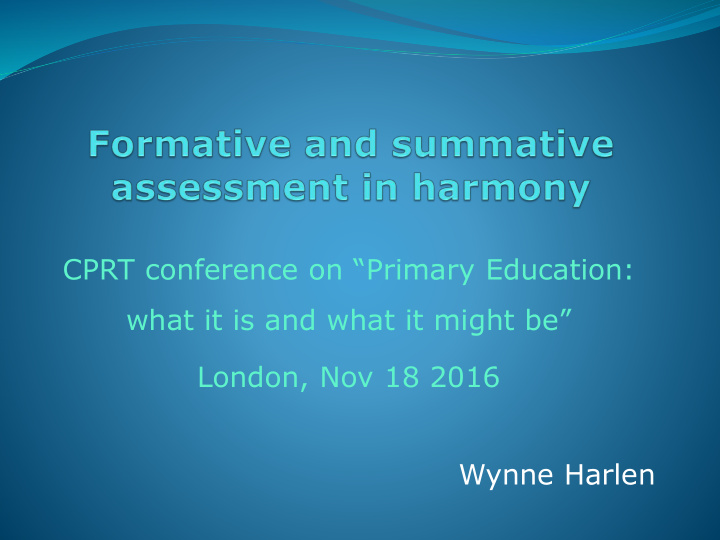



CPRT conference on “Primary Education: what it is and what it might be” London, Nov 18 2016 Wynne Harlen
Assessment purposes Formative (to help learning) Summative (to summarise, report and record learning achieved at a certain time). Both are needed but: only summative assessment is statutorily required some uses of summative assessment lead to neglect of formative assessment So we need to consider how both can work in harmony.
Model of formative assessment Activity Goals C Children’s activities B A Collection of evidence relating Decision about how to to goals take next steps Next steps Children in learning Evidence Decision Interpretation of evidence about next steps Judgement of achievement of activity goals for formative use
Why is it important? Empirical evidence: review of research by Black and Wiliam (1998) found that Implementing formative assessment can raise pupil achievement and the effect is larger than for any other intervention Lower-achieving pupils gain most so the gap between higher and lower achieving pupils is decreased Theoretical evidence: accords with constructivist views of learning (cognitive and socio-cultural)
Theories of learning Behaviourism (“Learning is being taught” ) Cognitive constructivism (“Learning is individual sense- making”) Socio- cultural constructivism (“Learning is building knowledge as part of doing things with others.”)
Implications of social constructivist view of learning Children will be: working in groups, exploring and manipulating physical materials, building on their prior experiences and ideas raising questions communicating their ideas listening to the ideas of others reasoning arguing from evidence etc.
Summative assessment Generating, collecting, interpreting and reporting evidence of learning at a particular time Relates to achievement of medium-term goals (end of year or stage) Used for a range of purposes (reporting, certifying achievement, school and teacher evaluation, etc) Uses evidence obtained by: administering tests or examinations summarising observations and records kept over time creating a portfolio of work embedding special tasks in regular activities computer-based tasks some combination of these.
Problems with tests Chosen approach because thought to be ‘fair’ but fairness is not treating pupils in exactly the same way Only a sample of the range of ideas, skills and content set out in the curriculum Involve language skills, particularly reading and writing Certain uses of results encourage ‘teaching to the test’ Often used as a guide to what to teach, limiting the experienced curriculum The process of testing conflicts with the view of learning.
Using tests Does this: give a valid assessment of learning like this:
Alternative to tests For valid assessment pupils need to be involved in using the skills and ideas that are being assessed Activities that provide opportunities for learning also provide opportunities for collecting evidence of progress in learning When formative assessment is being practised evidence is being collected about pupils’ ideas and skills across the full range of learning goals This evidence can be accumulated over time and brought together for summative reporting.
Activity Goals C Students’ activities B A Decision about how Collection of evidence to take next steps relating to goals Next steps Evidence Students in learning Accumulated over Decision several activities Interpretation about next steps of evidence Judgement Judgement against activity against medium- goals – for term goals – for formative use summative use Report
Using the ‘latest and best’ evidence Portfolio or computer file of evidence accumulated over the period for reporting Earlier pieces replaced by later ones (that is, the ‘latest and best’) Involving pupils in the selection (formative assessment) Evidence scanned against medium-term goals In this way: Summative assessment can cover the full range of learning goals Assessment is consistent with the curriculum – what is taught leads what is assessed, not vice versa .
Moving step by step… “As a first move in this direction, the system currently used for seven year olds should be adopted at the end of KS2; teacher assessment based on a range of evidence, including but not determined by a formal test.” ( David Reedy CPRT Blog 21 October 2016) Use frameworks already developed eg CLPE Reading and Writing scales; TAPS (Teacher Assessment in Primary science)
Recommend
More recommend